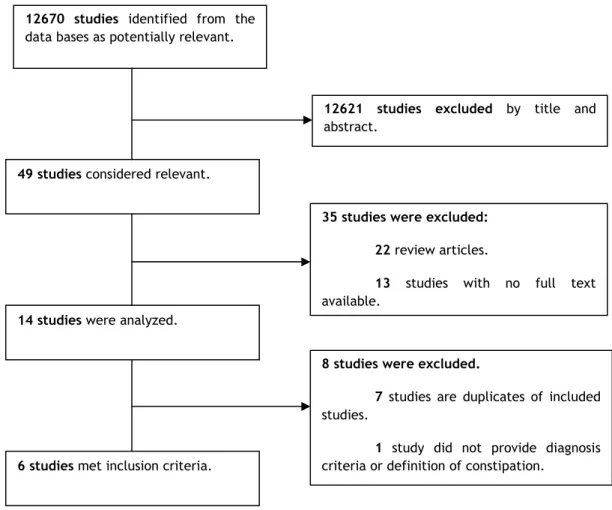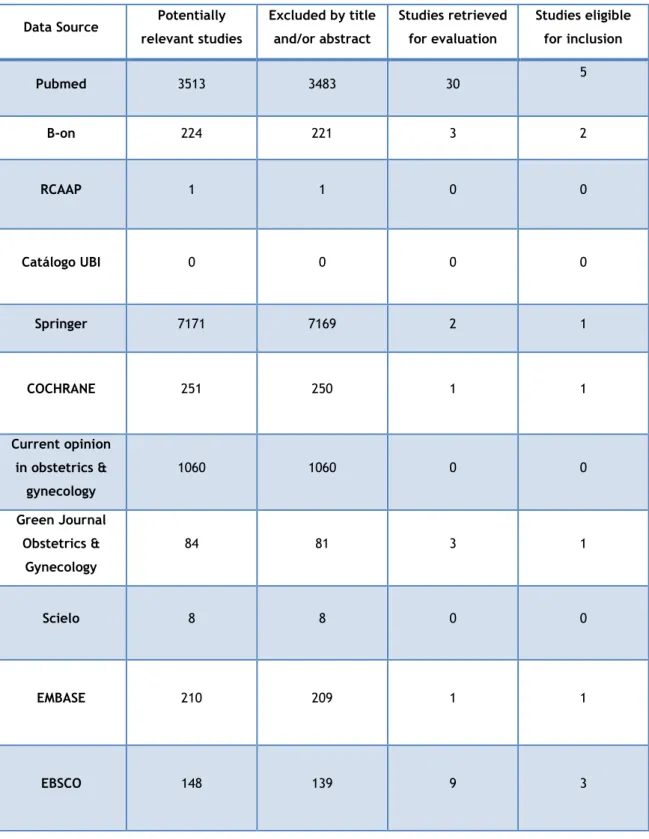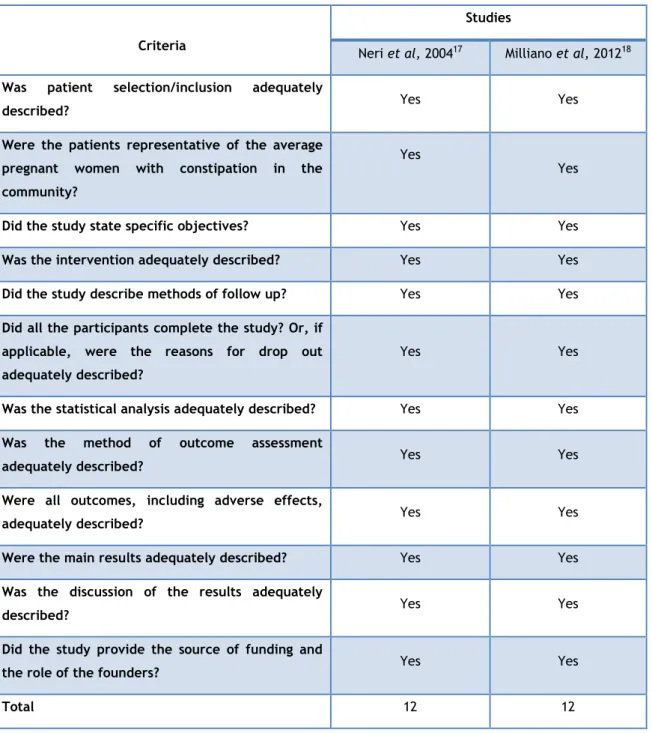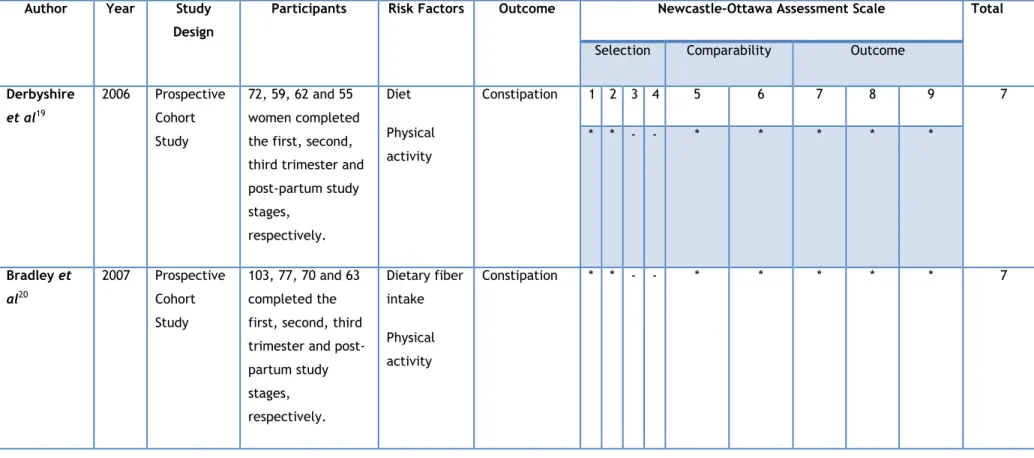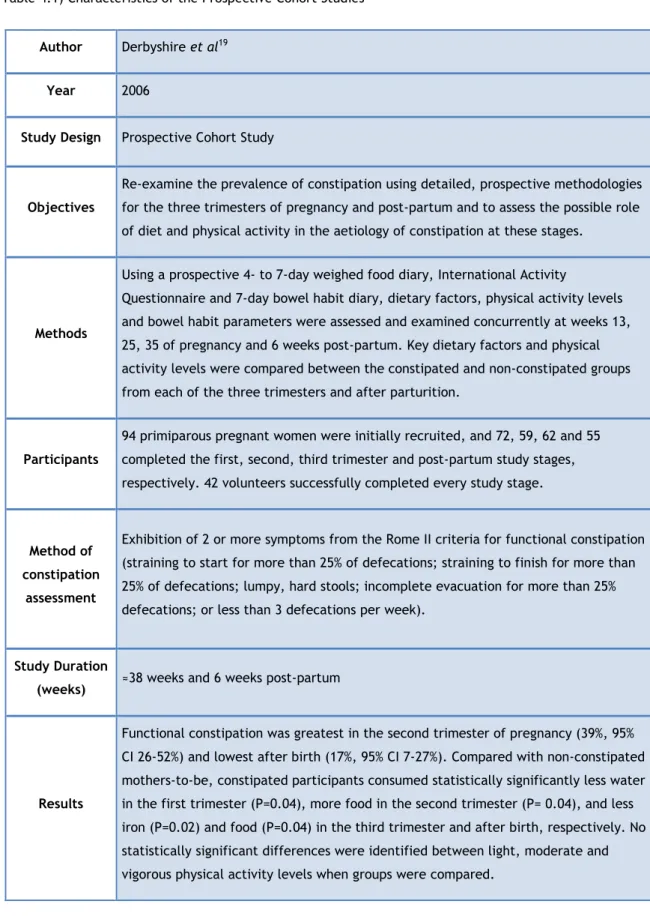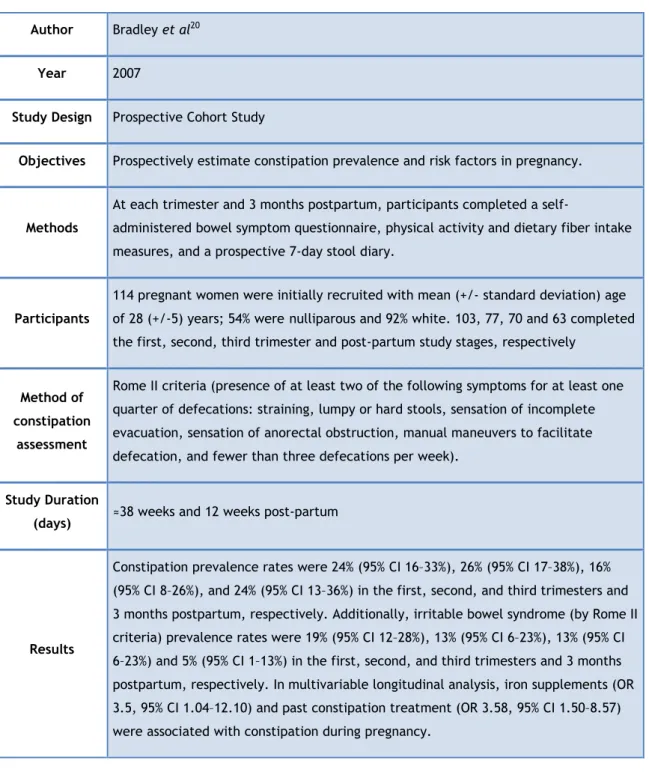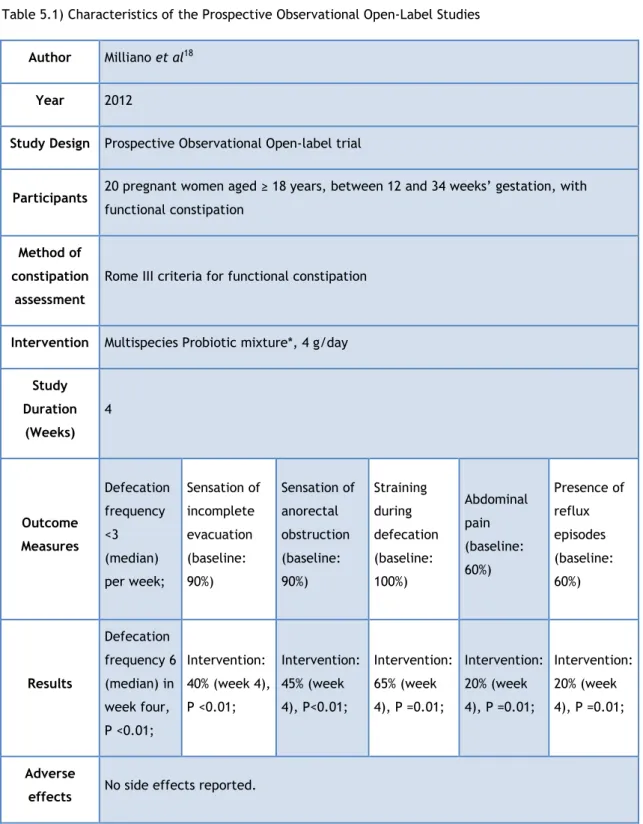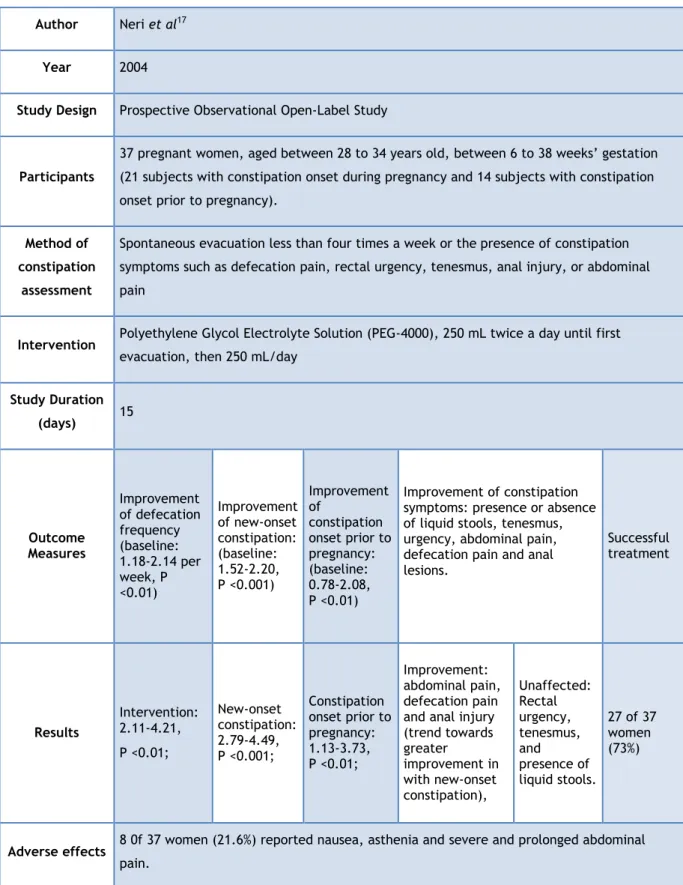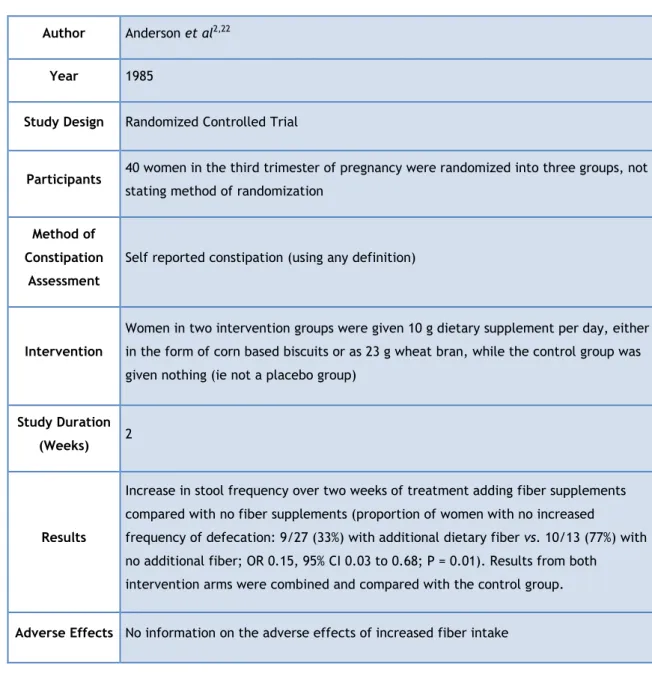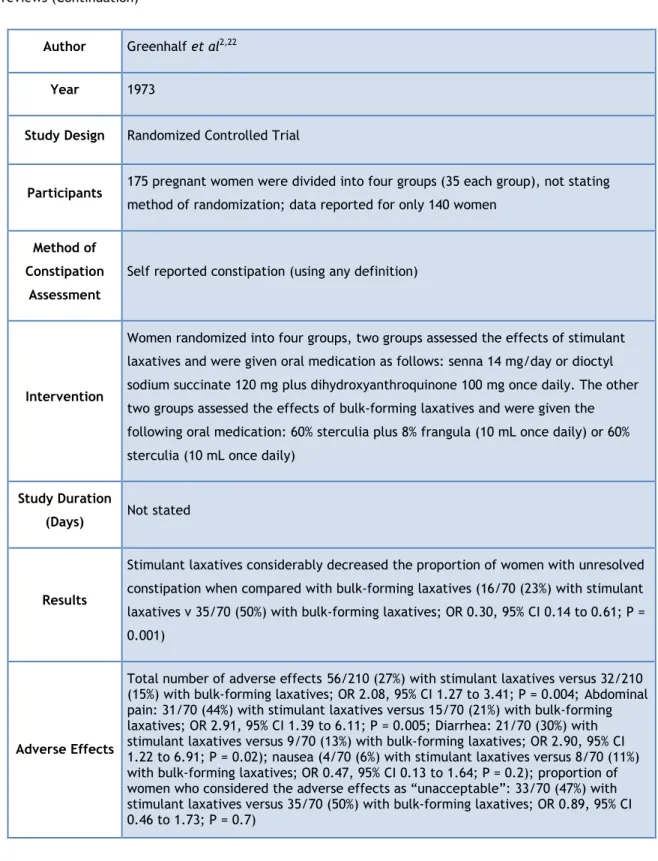UNIVERSIDADE DA BEIRA INTERIOR
Ciências da Saúde
Constipation in Pregnancy - A Systematic Review
Ana Sofia Rocha de Matos
Dissertação para obtenção do Grau de Mestre em
Medicina
(ciclo de estudos integrado)
Orientador: Prof. Doutor José Martinez de Oliveira
II
Agradecimentos
Ao meu orientador, Doutor José Martinez de Oliveira, por todo o apoio, disponibilidade e compreensão.
A todos os meus amigos e familiares que estiveram presentes e me apoiaram, permitindo-me ultrapassar as todas as adversidades. Um agradecimento especial aos meus amigos José Miguel e Lara, cujos conselhos foram imprescindíveis. Ao Nuno e à Susana, por toda a disponibilidade e simpatia.
Aos meus pais e irmão, Luís, que fizeram tudo o que estava ao seu alcance para me ajudar e sem os quais tudo teria sido muito mais difícil.
III
Resumo
A obstipação durante a gravidez é um problema comum. Habitualmente, não necessita de uma avaliação extensiva e a maioria das pacientes respondem a medidas simples. O tratamento geralmente consiste de medidas dietéticas, como o aumentode ingestão de fibras e fluidos, alterações comportamentais, tais como atividade física, assim como a utilização de probióticos ou laxantes. No entanto, o diagnóstico de obstipação em si é difícil de definir e pode variar de médico para médico.
Esta revisão sistematizada teve como objetivo identificar os critérios diagnósticos da obstipação durante a gravidez, a sua prevalência nos três trimestres, bem como os efeitos e a eficácia das diferentes intervenções para a sua prevenção ou tratamento.
A pesquisa incluiu os artigos disponíveis eletronicamente, usando as bases de dados Pubmed, B-on, RCAAP, Catálogo UBI, Springer, COCHRANE, Current Opinion in Obstetrics & Gynecology, Green Journal of Obstetrics & Gynecology, Scielo, EMBASE e EBSCO, e ainda pesquisa manual em livros de texto de referência considerados relevantes para o tema.
Apesar da sua relevância clínica existem poucos estudos de qualidade sobre o trânsito gastrointestinal em mulheres grávidas, identificação e tratamento da obstipação durante a gravidez.
Da revisão efetuada conclui-se que a prevalência de obstipação é maior durante o segundo trimestre da gravidez e menor no terceiro, constituindo os critérios de Roma III a definição mais aceitável. Relativamente ao tratamento da obstipação, durante a gravidez a ingestão abundante de líquidos associa-a a menor prevalência, enquanto que não há evidências de que dieta com fibra e atividade física melhorem a obstipação. Pelo contrário quer o uso de probióticos como duma solução eletrolítica de polietileno-glicol, um laxante osmótico, parecem ser tratamentos eficazes, mas não há provas suficientes sobre seus efeitos,pelo que podem ser necessários estudos subsequentes a fim de recomendar com segurança estes tratamentos. Por fim, os laxantes estimulantes podem ser mais eficazes do que os expansores de volume, embora os efeitos adversos, tais como dor abdominal e diarreia, possam limitar o seu uso. No entanto, esta conclusão está baseada num estudo antigo de e de qualidade muito baixa.
Concluindo: apesar da importância do tema não existem estudos de qualidade que suportem propostas fundamentadas sobre prevenção e tratamento da obstipação durante a gravidez.
Palavras-chave
IV
Abstract
Constipation during pregnancy is a common problem. It usually does not require an extensive evaluation and most patients respond to simple measures. Treatment typically consists of dietary measures, such as increasing fiber and fluid intake, behavioral changes, such as physical activity, and the use of probiotics or laxatives. However, the diagnosis of constipation itself is difficult to define and may vary from doctor to doctor.
This systematic review aimed to identify the diagnostic criteria of constipation during pregnancy, its prevalence during the three trimesters, as well as the effects and efficacy of different interventions for its prevention or treatment.
The survey included items available electronically, using databases such as Pubmed, B -on, RCAAP, UBI catalog, Springer, COCHRANE, Current Opinion in Obstetrics & Gynecology, Green Journal of Obstetrics & Gynecology, SciELO, EMBASE and EBSCO, and also manual research on textbooks of reference considered relevant to the topic.
Despite its clinical relevance, there are few quality studies on gastrointestinal transit in pregnant women, identification and treatment of constipation during pregnancy.
The present review concludes that the prevalence of constipation is higher during the second trimester of pregnancy and lower in the third, constituting the Rome III criteria the more acceptable definition. Regarding constipation treatment, during pregnancy abundant fluid intake was associated with a lower prevalence, whereas there is no evidence that dietary fiber and physical activity improve constipation. On the contrary, both the use of probiotics and an electrolyte solution of polyethylene glycol, an osmotic laxative, appear to be effective treatments, but there is insufficient evidence about its effects, therefore subsequent studies may be needed to safely recommend these treatments. Finally, stimulant laxatives may be more effective than bulk-forming laxatives, although adverse effects such as abdominal pain and diarrhea, may limit their use. However, this conclusion is based on an old and very low quality study.
In conclusion: despite the importance of the theme there are no quality studies that support grounded proposals on prevention and treatment of constipation during pregnancy.
Keywords
V
Table of Contents
Agradecimentos………II Resumo………III Abstract……….IV Table of Contents………V List of Figures………VII List of Tables ………VII List of Acronyms………VIIIChapter I — Introduction………1
Chapter II — Methods………4
2.1 — Data sources and Search Strategy………4
2.2 — Eligibility Criteria……….4
2.3 — Study Selection………5
2.4 — Data Extraction………5
2.5 — Study Quality Assessment……….……….………5
2.6 — Statistical Analysis………6
Chapter III — Results……….………7
3.1 — Studies Selection……….……….7
3.2 — Studies Quality ………9
3.3 — Study Characteristics………18
3.3.1 — Prevalence of constipation during pregnancy……….18
3.3.2 — Fiber Intake……….19
3.3.3 — Increased Fluid Intake………20
VI
3.3.5 — Probiotics……….…………20
3.3.6 — Osmotic Laxatives……….………21
3.3.7 — Stimulant Laxatives versus Bulk-Forming Laxatives………22
Chapter IV — Discussion………23
Conclusions………26
Bibliography……….27
Annex……….29
VII
List of Figures
Figure 1) Study Inclusion Process………7
List of Tables
Table 1) Study Selection by Data source………8Table 2) Quality of Non-Randomized, Non-Controlled Observational Studies………10
Table 3) Characteristics and Quality Assessment of the Cohort Studies Using the Newcastle-Ottawa Assessment Scale………11
Table 4.1) Characteristics of the Prospective Cohort Studies………12
Table 4.2) Characteristics of the Prospective Cohort Studies (Continuation)………13
Table 5.1) Characteristics of the Prospective Observational Open-Label Studies………14
Table 5.2) Characteristics of the Prospective Observational Open-Label Studies (Continuation)………15
Table 6.1) Characteristics of the Randomized Controlled Studies, data extracted from two systematic reviews………16
Table 6.2) Characteristics of the Randomized Controlled Studies, data extracted from two systematic reviews (Continuation)………17
VIII
List of Acronyms
CI: Confidence Interval
GRADE: Grading of Recommendations Assessment, Development and Evaluation NSP: Non-Starch Polysaccharide
OR: Odds ratio P: p-value
PEG: Polyethylene Glycol
PEG+E: Polyethylene Glycol plus electrolytes RCT: Randomized Controlled Trials
1
Chapter I
Introduction
Disorders of the gastrointestinal tract are common in pregnant women, and some such as constipation which can appear or aggravate during pregnancy1. The reported prevalence of constipation in pregnant women varies between 11% and 38%2. The majority of these women will attend their primary care physician or obstetrician with the refractory cases being referred to a gastroenterologist1.
The characterization of constipation itself is difficult to define and may vary from doctor to doctor, while many patients consider themselves constipated whenever there is a reduction in their normal bowel movements. Customarily, constipation is defined as difficulty in passing stool and infrequency of bowel motions, which is not secondary to an underlying cause3. The colon’s major functions are to conserve water, to facilitate bacterial digestion of dietary fiber and to retain and expel feces. Colonic motility, absorption and the internal and external sphincters affect these functions1.
According to the Portuguese Society of Gastroenterology, constipation is a persistent difficulty in evacuating, a need of great effort or even of manual maneuvers to facilitate defecation, or two or fewer bowel movements per week, or a recent reduction in the usual number of bowel movements4. Internationally, the Rome criteria are a standard clinical measure of assessing chronic constipation, according to which an individual is defined as being functionally constipated if he or she experiences at least two of the following: straining during at least 25% of defecations; lumpy, hard stools in at least 25% of defecations; sensation of incomplete evacuation for at least 25% or more of defecations; sensation of anorectal obstruction/blockage for at least 25% of defecations; manual maneuvers to facilitate at least 25% of defecations (e.g., digital evacuation, support of the pelvic floor);or less than 3 defecations per week5. These criteria may by extension include the absence of loose stools without the use of laxatives and/or those cases where there are insufficient criteria for irritable bowel syndrome. Finally, the diagnostic criteria must be fulfilled for the last 3 months with symptom onset at least 6 months prior to diagnosis6.
While constipation is a common complaint among the general population, some patients with no history of bowel problems develop constipation for the first time during pregnancy while others already suffering constipation prior to their pregnancies will often find their symptoms worsen while pregnant1,7. Although a definitive cause for this disturbing complaint remains
2
hormonal changes and mechanical changes play an important role, as well as dietary factors and lifestyle issues1.
Increased levels of progesterone during pregnancy increases bowel transit time and anatomical changes in the gastrointestinal tract such as uterine mechanical obstruction are considered major physiologic factors8, 9. Progesterone and somatostatin may also inhibit the
release of motilin, a peptide hormone that normally inhibits smooth muscle. Moreover, relaxin, a polypeptide that inhibits myometrial contraction during pregnancy, also appears to inhibit the smooth muscle of the gastrointestinal tract. According to Cullen et al, several animal studies have demonstrated the inhibitory effects of progesterone on both the circular and the longitudinal muscle layers of the colon, however human studies evaluating the influence of sex hormones on colonic motility and transit are rare and contradictory1.
It has also been proposed that the increase of colonic water absorption during pregnancy could lead to the formation of small and hard stools as, according to total colonic perfusion studies, aldosterone increases water absorption in pregnant women, particularly in the second trimester. Estrogens and progesterone increase the secretion of renin which converts angiotensinogen to angiotensin 1 which in turn is converted to angiotensin 2, leading to increased aldosterone levels as pregnancy progresses1.
Other important causes for constipation during pregnancy include dietary factors, such as a lack of dietary fiber; particularly non-starch polysaccharide (NSP) and water. Fiber binds water but this property is lost when it is split by colonic bacteria. Certain types of fiber (e.g. bran) are poorly splitted by bacteria and so retain their ability to bind water1. Dietary fiber increases both stools bulk, weight and frequency, and reduces the mean transit time10.
Light physical activity appears to promote regular bowel movements during pregnancy; therefore a sedentary lifestyle may likewise cause or exacerbate constipation11.
Generally, constipation during pregnancy does not require an extensive evaluation and most patients apparently respond to simple measures such as increasing dietary fiber, increase water intake and physical activity. The approach to constipation in pregnancy is similar to that used for the general population, with special attention to safety of medications12.
Current recommendations include dietary manipulations to increase the consumption of fiber. Fiber intake in pregnant women with constipation does not differ from that of pregnant women without constipation, but adding fiber to the diet in the form of a wheat or corn based supplement, bran and fruits with high moisture content like apples, pears and prunes may improve constipation symptoms12. It is also recommended to increase fluid intake and include a moderate amount of daily exercise9. Probiotics that alter the colonic flora can also improve bowel function8. If these are ineffective, laxatives are the second line of therapy,
3
however there have been few adequate studies concerning the effects of laxatives during pregnancy12.
A limited number of studies have been performed for specific laxatives and the safety of others can be implied from information about their systemic absorption8. Thus, in pregnant women, treatment using laxatives means that they are effective, non-teratogenic, not excreted in the breast milk and well tolerated1. Such laxatives include bulk-forming agents,
osmotic laxatives and stimulant laxatives.
Bulk-forming agents, such as psyllium, methylcellulose and hydrolyzed guar gum and calcium polycarbophil, are not absorbed or associated with increased risk of malformations; therefore, they are considered safe for long-term use during pregnancy8, 12. Osmotic laxatives are commonly used despite the lack of studies that confidently confirm their efficacy. Osmotic laxatives work by increasing the amount of fluid retained in the gut; they include sorbitol (70%), lactulose, polyethylene glycol, and magnesium-containing salts. Stimulant laxatives increase intestinal fluid secretion and may stimulate colonic motility; they are reserved for women who fail to respond to dietary measures, bulking agents, or osmotic laxatives. Stimulant laxatives include senna and bisacodyl12.
Constipation during pregnancy is usually disregarded as irrelevant; however it is an uncomfortable symptom that can also cause hemorrhoids, permanent impairment as there is evidence that straining to defecate can damage the pudendal nerve and impair the supportive function of the pelvic floor musculature while it is also an important factor in the development of uterovaginal prolapse13.
As ethical limitations of research in pregnancy prevented a clear etiology and incidence of constipation in pregnant women to be determined, the information available is sparse and most of what is currently known comes from research done over twenty years ago.
The aims of this systematic review were to gather the existent data through several studies on the diagnosis criteria for constipation during pregnancy, its prevalence during the three trimesters as well as the effects and efficacy of the different interventions to prevent or treat constipation in pregnancy.
4
Chapter II
Methods
2.1 — Data sources and Search Strategy
The survey data resorted to articles available electronically as well as articles with relevant references for theme’s the study.
The following data sources were used for this study:
• Pubmed; • B-on; • RCAAP; • Catálogo UBI; • Springer; • COCHRANE;
• Current opinion in obstetrics & gynecology; • Green Journal Obstetrics & gynecology • Scielo;
• EMBASE;
• EBSCO;
The keywords used to describe the study population were “pregnancy”, “pregnant”,
“gravidez”; “grávida”, “gestación”, “embarazo”, “constipation”, “obstipação”,
“constipação”, “constipación”, “diagnosis” and “diagnóstico”. These words were combined with key words referring to the different types of interventions that were investigated in the present review.
2.2 — Eligibility Criteria
The studies that were eligible for consideration in this systematic review were prospective studies with and without double blinding, randomized or not, cohort studies, systematic
5
reviews and second-line retrospective studies published in English, Portuguese or Spanish languages. No date restrictions were applied.
2.3 — Study Selection
Inclusion criteria were as it follows: the study population consisted of pregnant women, the studies included pregnant women diagnosed with constipation, diagnostic criteria for constipation were provided and a sub selection of studies evaluated the effects of nonpharmacologic and/or pharmacologic treatment for constipation during pregnancy. Case reports, studies of subjects with gastrointestinal diseases, irrelevant articles with nothing to add and articles with no full text available were excluded.
Using the keywords mentioned above on different databases, papers identified as potentially relevant for this review, were screened and excluded if title and abstract were not relevant for this review. Subsequently, the studies so selected were reviewed and those being single review articles or not having full text available were also excluded (exclusion criteria). The remaining studies were analyzed and, after excluding those that were duplicates of already included ones, they constituted the final sample, as eligible for inclusion.
2.4 — Data Extraction
The following data were obtained from each study: study design (randomized controlled trials (RTC), systematic reviews, prospective studies and retrospective studies), general manuscript information (author, journal, publication year), study design characteristics (sample size, study objectives, methods, method of constipation assessment, treatment and treatment duration), subject characteristics (age, pregnancy weeks), diagnosis tests, outcome measures and results (defecation frequency and other constipation symptoms before and after the treatment, and adverse effects).
2.5 — Study Quality Assessment
The studies’ quality assessment was evaluated following Cochrane Handbook for Systematic
Reviews of Interventions (Higgins and Green, version 5.1.0 updated March 2011)14. Therefore, after the selection of each study, a rating was assigned regarding its quality using different methods to evaluate the different study designs.
Unfortunately, no pre-existing quality assessment scale was found to rate non-randomized, non-controlled, prospective observational studies. Therefore, their quality was assessed by creating a scale based on the criteria list recommended by the STROBE Statement checklist of observational studies modified for the theme of this systematic review (Table 2)15. The Scale
6
“?” when the score is unclear. If studies met between 6 and 8 out of the 12 criteria, it was considered to have a moderate risk of bias (RoB) and, therefore, classified as a moderate quality study; if it met between 9 or more of the 12 criteria, the study was considered to have a low RoB and considered a high quality study; if only 5 or less of the criteria were met, the study was labeled as high RoB and low quality study.
The Newcastle-Ottawa Assessment Scale (Wells et al, 2000) was used for the cohort studies, whose method allocates a star to evaluate three items, namely: “selection”, “comparability” and “outcome”. The studies may obtain a minimum of 0 stars and a maximum of 9 stars16. As the original randomized controlled trials were unavailable, their quality assessment was taken directly from the two systematic reviews which provided the data.
2.5 — Statistical Analysis
This systematic review will be made under a narrative format. If quantitative data were available and significant the work aimed to perform a meta-analysis. This showed not to be the case.
7
35 studies were excluded:22 review articles.
13 studies with no full text
available.
12670 studies identified from the
data bases as potentially relevant.
12621 studies excluded by title and
abstract.
Chapter III
Results
3.1 — Studies Selection
The initial database search retrieved 12670 references, Pubmed being the database with more available articles. After screening the studies for inclusion criteria, 12621 studies were excluded by title and abstract and afterwards from the remaining 49 studies which were considered relevant, 35 were excluded (22 were review articles and 13 studies had no full text available). Ultimately, 14 full text articles were analyzed for eligibility and only 6 studies were included in the final analysis.
A flow chart of study inclusion and selection is shown in Figure 1 and Table 1 identifies the number of articles selected from each database.
49 studies considered relevant.
14 studies were analyzed.
8 studies were excluded.
7 studies are duplicates of included
studies.
1 study did not provide diagnosis
criteria or definition of constipation.
6 studies met inclusion criteria.
8
Table 1) Study Selection by Data source
Data Source Potentially relevant studies Excluded by title and/or abstract Studies retrieved for evaluation Studies eligible for inclusion Pubmed 3513 3483 30 5 B-on 224 221 3 2 RCAAP 1 1 0 0 Catálogo UBI 0 0 0 0 Springer 7171 7169 2 1 COCHRANE 251 250 1 1 Current opinion in obstetrics & gynecology 1060 1060 0 0 Green Journal Obstetrics & Gynecology 84 81 3 1 Scielo 8 8 0 0 EMBASE 210 209 1 1 EBSCO 148 139 9 3
9
3.2 — Studies Quality
Due to the non-existence of a preexisting quality assessment scale to rate non-randomized, non-controlled, prospective observational studies, a quality assessment scale was created to rate the two selected Observational Open-Label Studies (Table 2). Both studies met a 12 score from the 12 criteria, thus the studies were considered to have a low RoB and were considered as high quality studies.
The quality assessment of the cohort studies was rated using the Newcastle-Ottawa Assessment Scale (Table 3), with both studies (Derbyshire et al and Bradley et al) rating 7 stars out of 9, therefore both studies were considered as moderate quality studies19,20. However, both studies included a small sample size, resulting in sparse data.
Two randomized controlled trials were found in two systematic reviews as the original articles were unavailable, with each systematic review providing complementing data. One of the reviews (search date 2001) used the Cochrane Risk of Bias Tool to evaluate the RCTs regarding their allocation concealment, which prevents researchers from (unconsciously or otherwise) influencing which participants are assigned to a given intervention group. In both studies, this review considered the author’s judgment of unclear risk, meaning that there was insufficient information to assess whether an important risk of bias existed or there was insufficient rationale or evidence that an identified problem would introduce bias. Therefore, the studies were rated B for unclear risk of bias, moderate quality studies22. However, the other review (search date 2010) performed a GRADE evaluation of the quality of evidence for interventions2. GRADE tables grade the quality of evidence into four levels on the basis of
their confidence in the observed effect (a numerical value) being close to what the true effect is. The confidence value is based on judgments assigned in five different domains in a structured manner: type of evidence, quality, consistency, directness and effect size23. Consequently, this review rated Anderson et al with a low quality evidence level, deducting quality points for sparse data and for combination of results from 2 active treatment arms, deducting directness points for unspecific definition of constipation and for few comparators, meaning that further research is likely to change the presented conclusions completely. While Greenhalf et al was rated with a very low evidence level, deducting quality points for sparse data, uncertainty about randomization, no clear end point, and for combination of results from 2 active treatment arms. Directness point was deducted for unspecific definition of constipation. Meaning that the authors are not confident in the effect estimate and the true value may be substantially different, further research is likely to change the presented conclusions completely2. Taking in consideration the data available about these two RCTs, this review agrees with the Vazquez’s quality assessment.
10
CriteriaStudies
Neri et al, 200417 Milliano et al, 201218
Was patient selection/inclusion adequately
described? Yes Yes
Were the patients representative of the average pregnant women with constipation in the community?
Yes
Yes
Did the study state specific objectives? Yes Yes
Was the intervention adequately described? Yes Yes
Did the study describe methods of follow up? Yes Yes
Did all the participants complete the study? Or, if applicable, were the reasons for drop out adequately described?
Yes Yes
Was the statistical analysis adequately described? Yes Yes
Was the method of outcome assessment
adequately described? Yes Yes
Were all outcomes, including adverse effects,
adequately described? Yes Yes
Were the main results adequately described? Yes Yes
Was the discussion of the results adequately
described? Yes Yes
Did the study provide the source of funding and
the role of the founders? Yes Yes
Total 12 12
11
These cohort studies were considered as moderate quality studies. The selection of participants in both studies did not determine conclusively if they were exposed to the variables, as the patients self-reported the exposure, and the studies did not demonstrate that the outcome (constipation) was not present at the beginning of the study.
Author Year Study
Design
Participants Risk Factors Outcome Newcastle-Ottawa Assessment Scale Total
Selection Comparability Outcome
Derbyshire et al19 2006 Prospective Cohort Study 72, 59, 62 and 55 women completed the first, second, third trimester and post-partum study stages, respectively. Diet Physical activity Constipation 1 2 3 4 5 6 7 8 9 7 * * - - * * * * * Bradley et al20 2007 Prospective Cohort Study 103, 77, 70 and 63 completed the first, second, third trimester and post-partum study stages, respectively. Dietary fiber intake Physical activity Constipation * * - - * * * * * 7
12
Author Derbyshire et al19Year 2006
Study Design Prospective Cohort Study
Objectives
Re-examine the prevalence of constipation using detailed, prospective methodologies for the three trimesters of pregnancy and post-partum and to assess the possible role of diet and physical activity in the aetiology of constipation at these stages.
Methods
Using a prospective 4- to 7-day weighed food diary, International Activity
Questionnaire and 7-day bowel habit diary, dietary factors, physical activity levels and bowel habit parameters were assessed and examined concurrently at weeks 13, 25, 35 of pregnancy and 6 weeks post-partum. Key dietary factors and physical activity levels were compared between the constipated and non-constipated groups from each of the three trimesters and after parturition.
Participants
94 primiparous pregnant women were initially recruited, and 72, 59, 62 and 55 completed the first, second, third trimester and post-partum study stages, respectively. 42 volunteers successfully completed every study stage.
Method of constipation
assessment
Exhibition of 2 or more symptoms from the Rome II criteria for functional constipation (straining to start for more than 25% of defecations; straining to finish for more than 25% of defecations; lumpy, hard stools; incomplete evacuation for more than 25% defecations; or less than 3 defecations per week).
Study Duration
(weeks) ≈38 weeks and 6 weeks post-partum
Results
Functional constipation was greatest in the second trimester of pregnancy (39%, 95% CI 26-52%) and lowest after birth (17%, 95% CI 7-27%). Compared with non-constipated mothers-to-be, constipated participants consumed statistically significantly less water in the first trimester (P=0.04), more food in the second trimester (P= 0.04), and less iron (P=0.02) and food (P=0.04) in the third trimester and after birth, respectively. No statistically significant differences were identified between light, moderate and vigorous physical activity levels when groups were compared.
Derbyshire et al found that functional constipation was greatest in the second trimester of pregnancy, with 39% primiparous women experiencing constipation symptoms at this stage.
13
Author Bradley et al20Year 2007
Study Design Prospective Cohort Study
Objectives Prospectively estimate constipation prevalence and risk factors in pregnancy.
Methods
At each trimester and 3 months postpartum, participants completed a
self-administered bowel symptom questionnaire, physical activity and dietary fiber intake measures, and a prospective 7-day stool diary.
Participants
114 pregnant women were initially recruited with mean (+/- standard deviation) age of 28 (+/-5) years; 54% werenulliparous and 92% white. 103, 77, 70 and 63 completed the first, second, third trimester and post-partum study stages, respectively
Method of constipation
assessment
Rome II criteria (presence of at least two of the following symptoms for at least one quarter of defecations: straining, lumpy or hard stools, sensation of incomplete evacuation, sensation of anorectal obstruction, manual maneuvers to facilitate defecation, and fewer than three defecations per week).
Study Duration
(days) ≈38 weeks and 12 weeks post-partum
Results
Constipation prevalence rates were 24% (95% CI 16–33%), 26% (95% CI 17–38%), 16% (95% CI 8–26%), and 24% (95% CI 13–36%) in the first, second, and third trimesters and 3 months postpartum, respectively. Additionally, irritable bowel syndrome (by Rome II criteria) prevalence rates were 19% (95% CI 12–28%), 13% (95% CI 6–23%), 13% (95% CI 6–23%) and 5% (95% CI 1–13%) in the first, second, and third trimesters and 3 months postpartum, respectively. In multivariable longitudinal analysis, iron supplements (OR 3.5, 95% CI 1.04–12.10) and past constipation treatment (OR 3.58, 95% CI 1.50–8.57) were associated with constipation during pregnancy.
According to Bradley et al, constipation using the Rome II criteria affects up one fourth of women throughout pregnancy and 3 months postpartum.
14
Table 5.1) Characteristics of the Prospective Observational Open-Label Studies
Author Milliano et al18
Year 2012
Study Design Prospective Observational Open-label trial
Participants 20 pregnant women aged ≥ 18 years, between 12 and 34 weeks’ gestation, with
functional constipation
Method of constipation
assessment
Rome III criteria for functional constipation
Intervention Multispecies Probiotic mixture*, 4 g/day
Study Duration (Weeks) 4 Outcome Measures Defecation frequency <3 (median) per week; Sensation of incomplete evacuation (baseline: 90%) Sensation of anorectal obstruction (baseline: 90%) Straining during defecation (baseline: 100%) Abdominal pain (baseline: 60%) Presence of reflux episodes (baseline: 60%) Results Defecation frequency 6 (median) in week four, P <0.01; Intervention: 40% (week 4), P <0.01; Intervention: 45% (week 4), P<0.01; Intervention: 65% (week 4), P =0.01; Intervention: 20% (week 4), P =0.01; Intervention: 20% (week 4), P =0.01; Adverse
effects No side effects reported.
*Bifidobacterium bifidum W23, Bifidobacterium lactis W52, Bifidobacterium longum W108, Lactobacillus casei W79, Lactobacillus plantarum W62 and Lactobacillus rhamnosus W71.
Milliano et al observed a significant increase in defecation frequency using a multispecies probiotic mixture. Furthermore, several other constipation symptoms also improved and no adverse effects were reported during the study.
15
Author Neri et al17Year 2004
Study Design Prospective Observational Open-Label Study
Participants
37 pregnant women, aged between 28 to 34 years old, between 6 to 38 weeks’ gestation (21 subjects with constipation onset during pregnancy and 14 subjects with constipation onset prior to pregnancy).
Method of constipation
assessment
Spontaneous evacuation less than four times a week or the presence of constipation symptoms such as defecation pain, rectal urgency, tenesmus, anal injury, or abdominal pain
Intervention Polyethylene Glycol Electrolyte Solution (PEG-4000), 250 mL twice a day until first
evacuation, then 250 mL/day
Study Duration (days) 15 Outcome Measures Improvement of defecation frequency (baseline: 1.18-2.14 per week, P <0.01) Improvement of new-onset constipation: (baseline: 1.52-2.20, P <0.001) Improvement of constipation onset prior to pregnancy: (baseline: 0.78-2.08, P <0.01) Improvement of constipation symptoms: presence or absence of liquid stools, tenesmus, urgency, abdominal pain, defecation pain and anal lesions.
Successful treatment Results Intervention: 2.11-4.21, P <0.01; New-onset constipation: 2.79-4.49, P <0.001; Constipation onset prior to pregnancy: 1.13-3.73, P <0.01; Improvement: abdominal pain, defecation pain and anal injury (trend towards greater improvement in with new-onset constipation), Unaffected: Rectal urgency, tenesmus, and presence of liquid stools. 27 of 37 women (73%)
Adverse effects 8 0f 37 women (21.6%) reported nausea, asthenia and severe and prolonged abdominal
pain.
Neri et al found that both samples of women with a history of constipation either prior or developing during pregnancy, the administration of PEG-4000 for 15 days resulted in an increased evacuation frequency in 76.3% of women.
16
Author Anderson et al2,22Year 1985
Study Design Randomized Controlled Trial
Participants 40 women in the third trimester of pregnancy were randomized into three groups, not
stating method of randomization
Method of Constipation
Assessment
Self reported constipation (using any definition)
Intervention
Women in two intervention groups were given 10 g dietary supplement per day, either in the form of corn based biscuits or as 23 g wheat bran, while the control group was given nothing (ie not a placebo group)
Study Duration (Weeks) 2
Results
Increase in stool frequency over two weeks of treatment adding fiber supplements compared with no fiber supplements (proportion of women with no increased
frequency of defecation: 9/27 (33%) with additional dietary fiber vs. 10/13 (77%) with no additional fiber; OR 0.15, 95% CI 0.03 to 0.68; P = 0.01). Results from both intervention arms were combined and compared with the control group.
Adverse Effects No information on the adverse effects of increased fiber intake
According to Anderson et al, when compared with no treatment, additional dietary fiber may be more effective at increasing bowel frequency at 2 weeks in constipated pregnant women.
Table 6.1) Characteristics of the Randomized Controlled Studies, data extracted from two systematic reviews
17
Author Greenhalf et al2,22Year 1973
Study Design Randomized Controlled Trial
Participants 175 pregnant women were divided into four groups (35 each group), not stating
method of randomization; data reported for only 140 women
Method of Constipation
Assessment
Self reported constipation (using any definition)
Intervention
Women randomized into four groups, two groups assessed the effects of stimulant laxatives and were given oral medication as follows: senna 14 mg/day or dioctyl sodium succinate 120 mg plus dihydroxyanthroquinone 100 mg once daily. The other two groups assessed the effects of bulk-forming laxatives and were given the following oral medication: 60% sterculia plus 8% frangula (10 mL once daily) or 60% sterculia (10 mL once daily)
Study Duration
(Days) Not stated Results
Stimulant laxatives considerably decreased the proportion of women with unresolved constipation when compared with bulk-forming laxatives (16/70 (23%) with stimulant laxatives v 35/70 (50%) with bulk-forming laxatives; OR 0.30, 95% CI 0.14 to 0.61; P = 0.001)
Adverse Effects
Total number of adverse effects56/210 (27%) with stimulant laxatives versus 32/210 (15%) with bulk-forming laxatives; OR 2.08, 95% CI 1.27 to 3.41; P = 0.004;Abdominal pain: 31/70 (44%) with stimulant laxatives versus 15/70 (21%) with bulk-forming laxatives; OR 2.91, 95% CI 1.39 to 6.11; P = 0.005; Diarrhea: 21/70 (30%) with stimulant laxatives versus 9/70 (13%) with bulk-forming laxatives; OR 2.90, 95% CI 1.22 to 6.91; P = 0.02); nausea (4/70 (6%) with stimulant laxatives versus 8/70 (11%) with bulk-forming laxatives; OR 0.47, 95% CI 0.13 to 1.64; P = 0.2); proportion of women who considered the adverse effects as “unacceptable”: 33/70 (47%) with stimulant laxatives versus 35/70 (50%) with bulk-forming laxatives; OR 0.89, 95% CI 0.46 to 1.73; P = 0.7)
According to Greenhalf et al, when compared with bulk-forming laxatives, stimulant laxatives may be more effective at reducing the proportion of women with unresolved constipation.
Table 6.2) Characteristics of the Randomized Controlled Studies, data extracted from two systematic reviews (Continuation)
18
3.3 — Study Characteristics
The six studies selected as eligible for this systematic review included two prospective cohort studies, two observational open-label studies and two randomized controlled trials (RCT) whose data was compiled from two different systematic reviews, search date 2001 and 2010, respectively, as the original articles were unavailable and each systematic review provided complementing data. The two prospective cohort studies estimated the prevalence of constipation during pregnancy while the remaining studies assessed the efficacy and effects of different treatments on pregnant women with constipation. Tables 4.1, 4.2, 5.1, 5.2, 6.1 and 6.2 feature the characteristics of the studies included.
The six studies included survey data collected between 1973 and 2012. The sample sizes were small, ranging from 20 to 140 participants18,22. All studies included pregnant women;
however, only four studies selected pregnant women with constipation. Also, all studies excluded patients with other gastrointestinal disorders, except for the RTCs which do not provide the data.
The studies were highly diverse with regard to the participants, interventions and outcome measures; also there were no available data, only the studies’ results which prevents further statistical analysis. Therefore, a meta-analysis of all included studies could not be performed. Consequently, the studies’ analysis is done separately.
3.3.1 — Prevalence of constipation during pregnancy
Two prospective cohort studies were found with moderate study quality (Table 3). Both estimated the prevalence of constipation throughout and after pregnancy as well as its risk factors, using small population samples, through self-administered questionnaires and diaries. They also both used the Rome II criteria to define constipation.
Derbyshire et al collected data at each trimester and 6 weeks post-partum from primiparous pregnant women exclusively (Table 4.1). From the 94 subjects that were initially recruited only 42 successfully completed every study stage, an overall compliance rate of 42%. The study estimates that the prevalence of constipation within the sample population was greatest in the first and second trimesters, 35% (95% CI 23-47%) and 39% (95% CI 26-52%) respectively, decreasing in the third trimester, 21% (95% CI 10-32%), and at 6 six weeks post-partum, 17% (95% CI 7-27%). The mean prevalence rate of constipation during pregnancy of this study was 32%19.
The second study, Bradley et al, also collected data at each trimester and 3 months post-partum. The follow-up data were returned by 63 women (61.2%) at 3 months post-partum out of the 103 women who initially returned the data in the first trimester (Table 4.2). The loss to follow-up was not explained, but rather suggested that the participants who failed to
19
return the questionnaires were likely to be non-white, less educated, single and of higher parity than the women who did. This study estimates that constipation prevalence rates were 24% in the first trimester (95% CI 16–33%), 26% in the second (95% CI 17–38%), 16% in the third (95% CI 8–26%), and 24% and 3 months postpartum (95% CI 13–36%). Overall, 51% women (95% CI 39-62%) reported constipation at some point during pregnancy. This study states that functional constipation, defined using the Rome II criteria, occurred in 16–26% of women studied in each pregnancy trimester.
Bradley et al state that while other studies reported variable rates of constipation during pregnancy (11-38%), these studies were limited by their retrospective study design and the use of non-validated and non-standardized definitions of constipation, which focused solely on bowel movement frequency while their study demonstrates that other symptoms of straining, lumpy or hard stools, and sensation of incomplete evacuation were more commonly reported than infrequent defections. This study also estimates that women who reported a history of constipation (41.7%, P=0.04) were more likely to develop constipation during pregnancy20.
3.3.2 — Fiber Intake
Derbyshire et al aimed to evaluate the possible role of diet in the etiology of constipation during pregnancy, collecting data through food diaries. This study estimated that food intake
(
g/day) was significantly higher in constipated women in the second trimester, P=0.04 and lower in constipated subjects after birth (P=0.04). Unfortunately, it did not specify the amount of fiber consumed19.Bradley et al used questionnaires to assess the correlation between constipation during pregnancy and the amount of daily fiber intake. They found no significant difference between women with constipation and women without constipation in the first trimester regarding fiber intake (mean (SD) 17.2 g/day (5.6) compared with 17.5 g/day (5.2), P=0.81) and fiber supplementation (3 (12.5%) compared with 3 (4.0%), P=0.15)20.
Two systematic reviews were found and included one RCT (Table 6.1) comparing the effects of increased fiber intake versus no treatment among pregnant women with self-reported constipation during the third trimester2,22. This study found an increase in stool frequency over two weeks of treatment adding fiber supplements when compared with no fiber supplements (women with no increased frequency of defecation: 33% with additional dietary fiber versus 77% with no additional fiber; OR 0.15, 95% CI 0.03 to 0.68; P = 0.01). In one review, results from both intervention arms were combined and compared with the control group22. This study also found no differences in outcomes between the group that was given
corn-based biscuits and the group that was given wheat bran which was expected as the two are different forms of fiber (i.e. the same type of laxative)22.
20
3.3.3 — Increased Fluid IntakeDerbyshire et al also aimed to evaluate the association between water intake and constipation during pregnancy through food diaries. The study estimates that water consumption was significantly statistically lower in the first trimester in constipated mothers when compared with non-constipated subjects in the same trimester (P=0.04)19.
No subsequent studies were found concerning implementing fluid intake for the treatment of constipation in pregnancy.
3.3.4 — Physical Activity
The two cohort studies estimated that physical activity was not strongly associated with constipation in pregnancy. Derbyshire et al, along with other variables mentioned above, aimed to evaluate the association between physical activity and constipation during pregnancy through a physical activity questionnaire, in order to obtain total time spent participating in different strengths activities. The study estimates that non-constipated subjects participated in higher levels of vigorous, moderate and light activity in the first two trimesters of pregnancy (min/day), while constipated subjects undertook higher levels of vigorous and moderate activities in the third trimester and after birth. However, the study admits that these findings were not statistically significant19. In addition, Bradley et al, also through questionnaires, found that physical activity levels of constipated women compared with non-constipated women in the first trimester did not differ (12 (50%) compared with 43 (55.1%) sufficiently or highly active, P=0.83), considering highly active the subjects who participated at least one hour or more per day of at least moderate-intensity activity above the basal level of physical activity, and sufficiently active those who participated at least half an hour of at least moderate-intensity physical activity on most days20,21.
No subsequent studies were found related to increasing physical activity for the treatment of constipation in pregnancy.
3.3.5 — Probiotics
Only one prospective observational open-label study evaluating the efficacy of a probiotic mixture in the treatment of constipation in pregnancy during four weeks of treatment was identified (Table 5.1). Constipation was defined according to the Rome III criteria for functional constipation.
The study found that the median defecation frequency per week significantly increased from 3.0 at baseline to 7.0 in week two (p < 0.01) and 6.0 in week four (p < 0.01). In addition, when compared to baseline, the study found that there was a significant decrease in sensation of anorectal obstruction (90% to 45%; P < 0.01),sensation of incomplete evacuation
21
(90.0% to 40.0%; p < 0.01), straining during defecation (100% to 65%; p = 0.01), episodes of abdominal pain (60% to 20%; p = 0.01) and the presence of reflux episodes (60% to 20% in week four; p = 0.01). Other secondary outcomes, such as hard stools, did not decrease significantly. No adverse effects were reported18.
No subsequent studies were found proposing probiotics for the treatment of constipation in pregnancy.
3.3.6 — Osmotic Laxatives
Found one observational open-label study evaluating the efficacy of a polyethylene glycol electrolyte solution (PEG-4000) in the treatment of constipation in pregnancy for 15 days (Table 5.2). Constipation was defined as spontaneous evacuation less than four times a week or the presence of constipation symptoms such as defecation pain, rectal urgency, tenesmus, anal injury, or abdominal pain.
According to this study’s results, treatment with PEG-4000 significantly increased the mean number of evacuation episodes per week (from 1.18–2.14 prior to treatment to 2.11–4.21 during treatment; P < 0.01) with resolved constipation in 27 women (73%). This study also found that the prevalence of other constipation symptoms decreased after the treatment such as defecation pain, anal injury and abdominal pain whereas rectal urgency, tenesmus, and presence of liquid stools remained unaffected; however, this data is only in the form of a graphic chart, without the actual results stated.
The study found that several constipation symptoms such as rectal urgency, tenesmus, abdominal pain and presence of liquid stools were more frequent in subjects with constipation history prior to their pregnancy when compared with those whose constipation onset occurred during pregnancy, while no differences were observed between the two groups regarding defecation pain and anal injury. According to the study, treatment with PEG-4000 improved bowel habits in both groups (group with new-onset constipation, the number of evacuations per week increased from 1.52–2.20 to 2.79–4.49; P < 0.001, and in the group with a history of constipation prior to pregnancy, evacuations increased from 0.78–2.08 to 1.13–3.73; P < 0.01). Defecation pain and anal injury showed greater improvement in women that experienced onset of constipation during pregnancy when compared to those with constipation history before pregnancy.
In opposition, eight (21.6%) of the 37 women who completed the study reported side effects such as nausea, asthenia, and severe and prolonged abdominal pain during the study period. No subsequent studies were found about osmotic laxatives for the treatment of constipation in pregnancy.
22
3.3.7 — Stimulant Laxatives versus Bulk-Forming LaxativesTwo systematic reviews were found and included one RCT (Table 6.2) which compared stimulant laxatives with bulk-forming laxatives among pregnant women with self-reported constipation2,22. The duration of treatment was not reported.
The RCT identified by the systematic reviews found that stimulant laxatives (16/70; 23%) considerably decreased the proportion of women with unresolved constipation when compared with bulk-forming laxatives (35/70; 50%); OR 0.30, 95% CI 0.14 to 0.61; P = 0.001). However, this study found that stimulant laxatives significantly increased the proportion of women with adverse effects such as diarrhea and abdominal pain when compared with bulk-forming agents, while there was no significant difference between the groups to nausea or proportion of women who considered the adverse effects as “unacceptable”, which were high on both interventions (33/70 (47%) with stimulant laxatives versus 35/70 (50%) with bulk-forming laxatives; OR 0.89, 95% CI 0.46 to 1.73; P = 0.7). The criteria used for stating the adverse effects of the treatment as “unacceptable” were not stated in the review2.
One review combined the results from the two stimulant-laxative arms and the two bulk-forming-laxative arms to perform the meta-analysis22.
No subsequent studies were found about stimulant laxatives or bulk-forming laxatives for the treatment of constipation in pregnancy.
23
Chapter IV
Discussion
This systematic review shows that not only there are few eligible studies regarding constipation during pregnancy, but also a lack of adequately powered, high quality studies. It should also be noted that all studies had small population samples which can result in the lack of statistical representation.
Both prospective cohort studies reached similar results regarding the higher prevalence of constipation during the second trimester lowering during the third one, thus it seems that the endocrinal changes of pregnancy are more likely the cause of constipation, as opposed to anatomical changes, which were supposed to exert their influence during the third trimester. Although both prospective cohort studies were of moderate quality, the studies suffered from loss to follow-up from their already small population sample. This review also found that using diaries to collect the data could have been too tiresome for the participants and it could also be a plausible reason for the descending compliance rate.
Studies regarding fiber intake stated opposing results. Bradley et al (2007) found a lack of association between dietary fiber intake and constipation during pregnancy, while Anderson
et al (1985) found an increase in stool frequency over two weeks of treatment adding fiber supplements compared with no treatment2,20,22. Nevertheless, as with the general population, it is reasonable to recommend an increase of dietary fiber during pregnancy to women with known dietary fiber deficiency24. Fiber should be given in the form of foods such as wheat, vegetables, and wholemeal bread. However, ingesting large quantities of fiber too rapidly can cause increased abdominal bloating, gas, cramping, and diarrhea12. Also, according to some studies, high intakes of non-starch polysaccharide can result in calcium, iron, or zinc deficiencies during pregnancy, although these results have been controversial24.
Water intake was only addressed in the Derbyshire et al study, which estimates that water consumption was significantly lower in constipated mothers during the first trimester19. Despite the limited evidence, increasing fluid intake should be one of the first measures used to treat constipation in pregnancy, which may be taken in either beverages or in foods with high moisture content such as certain fruits1. It should also be noted that increase fluid intake is not expensive, is readily available and has several additional benefits during pregnancy.
Both Derbyshire et al and Bradley et al also found a lack of association between physical activity and constipation during pregnancy19,20. Despite de lack of evidence, it is reasonable
24
Despite the lack of evidence on the treatment of constipation during pregnancy using probiotics, Milliano et al (2012) found that there was a significant increase in defecation frequency along with the improvement of many constipation symptoms18. Also, probiotics have shown to be safe for both mother and fetus during pregnancy as several studies did not report adverse effects related to probiotics and has a low risk of absortion25. Therefore, these findings suggest that treating constipation during pregnancy with probiotics may be effective. However, more studies are required in order to safely recommend this treatment.
The studies found concerning the use of laxatives during pregnancy were very limited. Neri et
al (2004) found that PEG-4000 (osmotic laxative) was associated with an increased of evacuation frequency and constipation symptoms, such as defecation pain, anal injury, and abdominal pain, also significantly improved17. Polyethylene glycol-balanced electrolyte solution such as PEG-4000 may be an effective treatment for constipation during pregnancy, with few significant neonatal and maternal side effects. In addition, according to a panel of experts, polyethylene glycol (PEG)-based osmotic laxatives plus electrolytes (PEG+E) may be ideal laxative to use during pregnancy since the absorption is minimal and no signs of teratogenicity in animal studies have been found. However, there is insufficient information on the potential effects on the fetus of PEG+E7. Also, according to the open-label study mentioned above, polyethylene glycol-balanced electrolyte was associated with adverse effects such as nausea, asthenia, and severe and prolonged abdominal pain. Moreover, due to the small size of the sample and the lack of control group, the findings can only be considered preliminary. Therefore, there is insufficient evidence about the effects of PEG+E on constipation during pregnancy, thus its use cannot be recommended without further research.
The RCT (Greenhalf et al. 1973) found in the systematic reviews, which compared stimulant laxatives with bulk-forming laxatives, found that stimulant laxatives maybe more effective than bulk-forming laxatives in improving constipation in pregnancy, but was associated with an increase of the proportion of women with adverse effects when compared with bulk-forming laxatives, thus it could limit their use on women who cannot tolerate them. There is little evidence of benefit for stimulant laxatives compared to bulk-forming laxatives. Furthermore, not only there are high absolute rates of adverse effects with both stimulant and bulk-forming laxatives, but also, bulk-forming laxatives take several days to exert their effect and are not suitable for acute relief7. However, since stimulant laxatives are associated with more adverse effects such as abdominal pain and diarrhea, it may be preferable to use bulk-forming laxatives in pregnant women who do not tolerate stimulant laxatives. According to a group of experts, stimulant laxatives should be used with caution during pregnancy and lactation because senna can be excreted in breast milk7. It should also be noted that the RCT which compared stimulant laxatives with bulk-forming laxatives is over forty years old and was considered as a very-low quality study as the method of
25
randomization and the duration of the intervention were not stated and it did not provide diagnostic criteria for constipation.
The main problem faced while doing this review were the limited studies and articles regarding constipation during pregnancy, as a result some conclusions are based on only one or two studies. As an aggravating factor, from the few existing literature, the vast majority are observational studies, there are few RCTs relating to this subject. Preferably, the systematic review would include RCTs, whose information is of higher quality than observational studies. Moreover, the original RCTs used in this review were unavailable, thus their findings had to be compiled from two existing systematic reviews.
26
Conclusions
Evidence shows that the prevalence of constipation is higher during the second trimester of pregnancy. Also, constipation symptoms tend to be more frequent in women with a history of constipation prior to pregnancy. However, considering the small population samples of the studies and their data collection methods, further research is necessary, thus a prospective cohort study protocol is attached to this review.
Regarding the lack of association between dietary fiber intake and physical activity with constipation during pregnancy found in both cohort studies as well as the limited evidence whether increasing fluid intake improves constipation in pregnancy, further research using detailed prospective methodologies is required to investigate the associations between these variables and constipation during and after pregnancy. Nevertheless, increase in fiber intake, fluid consumption and physical activity should be the first line of treatment as they are safe and logical, if accompanied by an adequate amount of fluid intake. Probiotics have also shown potential for treating constipation. If these are ineffective, laxatives should be the second line of therapy. An osmotic laxative, PEG-4000, maybe an effective choice for the treatment of constipation during pregnancy, while bulk-forming laxatives, though less effective than stimulant laxatives, can be used when women can tolerate stimulant laxatives. Finally, stimulant laxatives maybe more effective than bulk-forming laxatives, but they are associated with adverse effects that could limit their use. The studies available on the treatment of constipation during pregnancy with laxatives are limited and, in some cases, old, therefore, more studies should be required in the future, preferably high quality RTCs to investigate the efficacy, safety, and cost-effectiveness of the different treatment forms, using homogeneous patient populations and outcome measures, including standard definitions as described in the Rome III criteria.
27
Bibliography
1. Cullen G, O’Donoghue D. Constipation and pregnancy. Best Practice & Research Clinical Gastroenterology. 2007; 21(5):807–818.
2. Vazquez J. Constipation, haemorrhoids, and heartburn in pregnancy. Clinical Evidence. 2010 Feb; 8:1-17.
3. Moriarty KJ, Irving MH. ABC of colorectal disease. Constipation. Br Med J. 1992; 304: 1237-1240.
4. O que é? Obstipação [panfleto]. Sociedade Portuguesa de Gastrenterologia; 2006. 5. Rome foundation. Guidelines—Rome 3 diagnostic criteria for functional
gastrointestinal disorders. J Gastrointestin Liver Dis. 2006 Sep; 15(3):307–312.
6. Longstreth G, Thompson W, Chey W, Houghton L, Mearin F, Spiller R. Functional Bowel Disorders. Gastroenterology. 2006; 130:1480-1491.
7. Tytgat G, Heading R, Muller-Lissner S, Kamm M, Scholmerich J, Berstad A, Fried M, Chaussade S, Jewell D, Briggs A. Contemporary understanding and management of reflux and constipation in the general population and pregnancy: a consensus meeting. Aliment Pharmacol Ther. 2003; 18(3):291–301.
8. Trottier M, Erebara A, Bozzo P. Treating constipation during pregnancy. Canadian Family Physician. 2012 Ag; 58:836-838.
9. Longo S, Moore R., Canzoneri B, Robichaux A. Gastrointestinal Conditions during Pregnancy. Clinics In Colon And Rectal Surgery. 2010; 23(2):80-89.
10. Stevenson L, Phillips F, O'sullivan K, Walton J. Wheat bran: its composition and benefits to health, a European perspective. International Journal of Food Sciences and Nutrition. 2012 Dec; 63(8):1001–1013.
11. Artal R, O’Toole M. Guidelines of the American college of obstetricians and gynaecologists for exercise during pregnancy and the postpartum period. Br J Sports Med. 2003; 37:6–12.
12. Prather C. Pregnancy-related Constipation. Current Gastroenterology Reports. 2004; 6:402-404.
13. Marshall K, Thompson K, Walsh D, Baxter G. Incidence of urinary incontinence and constipation during pregnancy and postpartum: survey of current findings at the Rotunda Lying-in Hospital. British Journal of Obstetrics and Gynaecology. 1998; 105:400-402.
14. Higgins J.P.T, Green S. Cochrane Handbook for Systematic Reviews of Interventions, Version 5.1.0 [Internet]. The Cochrane Collaboration; 2008. [updated 2011 March; cited 2014 January 20]. Available from: www.cochrane-handbook.org
15. von Elm E, Altman DG, Egger M, Pocock SJ, Gøtzsche PC, Vandenbroucke JP. The Strengthening the Reporting of Observational Studies in Epidemiology (STROBE)
28
statement: guidelines for reporting observational studies. Bull World Health Organ. 2007 Nov; 85(11):867-72
16. Wells G.A, Shea B, O’Connell D, et al. The Newcastle-Ottawa Scale (NOS) for assessing the quality of nonrandomized studies in meta-analyses [Internet]. 2000. [Cited
January 20 2014]. Available from:
http://www.ohri.ca/programs/clinical_epidemiology/nosgen.doc
17. Neri I, Blasi I, Castro P, Grandinetti G, Ricchi A, Facchinetti F. Polyethylene glycol electrolyte solution (Isocolan) for constipation during pregnancy: an observational open-label study. Journal of Midwifery & Women’s Health. 2004 Jul/Aug; 49(4):355-358.
18. Milliano I, Tabbers M, Post J, Benninga M. Is a multispecies probiotic mixture effective in constipation during pregnancy? 'A pilot study'. Nutrition Journal. 2012; 11(80):1-6. 19. Derbyshire E, Davies J, Costarelli V, Dettmar P. Diet, physical inactivity and the
prevalence of constipation throughout and after pregnancy. Maternal and Child Nutrition. 2006; 2:127–134.
20. Bradley C, Kennedy C, Turcea A, Rao S, Nygaard I. Constipation in Pregnancy: Prevalence, Symptoms, and Risk Factors. Obstetricians & Gynecologists. 2007 Dec; 110(6):1351-1357.
21. Craig CL, Marshall AL, Sjostrom M, Bauman AE, Booth ML, Ainsworth BE, et al. International physical activity questionnaire: 12-country reliability and validity. Med Sci Sports Exerc. 2003; 35:1381–1395.
22. Jewell DJ, Young G. Interventions for treating constipation in pregnancy. In: The Cochrane Library, Issue 1, 2010. Chichester, UK: John Wiley & Sons, Ltd. Search date 2001.
23. Balshem H, Helfand M, Schünemann H, Oxman A, Kunz R, Brozek J, Vist G, Falck-Ytter Y, Meerpohl J, Norris S, Guyatt G. GRADE guidelines: 3. Rating the quality of evidence. Journal of Clinical Epidemiology. 2011; 64(4):401-406.
24. Derbyshire, E. The importance of adequate fluid and fibre intake during pregnancy. Nursing Standard. 2007; 21:40–43.
25. Elias J, Bozzo P, Einarson A. Are probiotics safe for use during pregnancy and lactation? Canadian Family Physician. 2011; 57:299–301.
29
Annex
Prevalence of Constipation in Pregnancy: A Prospective,
Longitudinal Study Protocol
Introduction
Constipation is a common complaint during pregnancy, which is usually regarded as irrelevant and a normal part of gestation. Nevertheless, constipation is an uncomfortable symptom which can cause other complications such as hemorrhoids.
Few studies appear to have investigated the prevalence of constipation and its association with risk factors, such as diet, water intake and physical activity, for all three trimesters or after birth. Unfortunately, those available lack the quality or the sample size necessary to reach definitive conclusions.
Objectives
The objective of this protocol it to prospectively estimate constipation prevalence and risk factors in pregnancy. The study’s duration should include all three trimesters of the gestative period and six weeks post-partum.
1. Recruit pregnant women once pregnancy has been confirmed and as soon as women are willing to participate in the study.
2. Present volunteers with a screening questionnaire for eligibility including the participant’s name, age, weeks of gestation, current employment status, diseases (past and present), previous treatments, current medication and dietary supplements, usual bowel frequency, history of constipation, dietary habits, water intake habits, physical activity level.
2.1. Inclusion criteria: women in their first trimester of pregnancy, age at least 18 years old, planning to continue prenatal care and delivery;
2.2. Exclusion criteria: diagnosis of mental retardation, Hirschsprung’s disease, malignant intestinal diseases, severe pregnancy complications at the time of enrollment, previous abdominal or pelvic radiation therapy, history of inflammatory bowel disease, history of bowel surgery (apart from appendectomy), current treatment for thyroid disease and regular narcotic use; 3. Provide a self-administered questionnaire immediately after enrollment and give the
